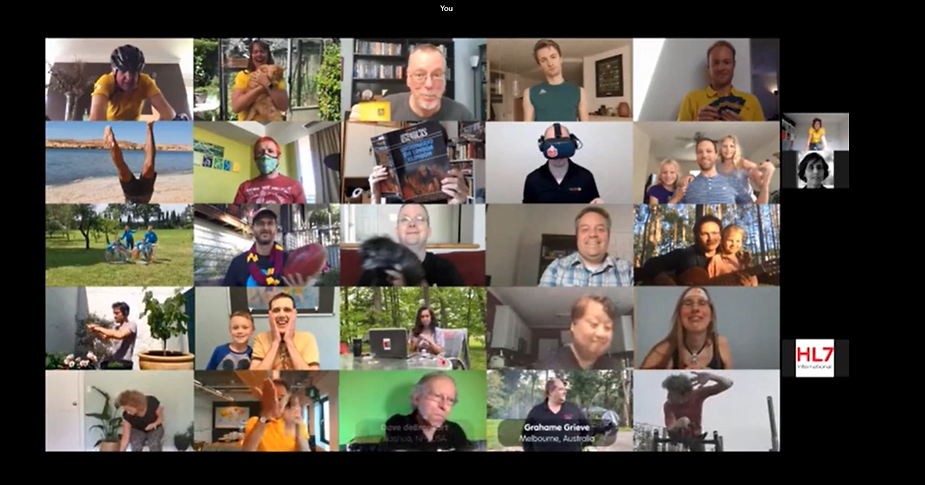Last week, the Dynamic Health IT team (DHIT) attended the FHIR DevDays event hosted by HL7 and Firely. FHIR Dev Days US 2020 was not the first virtual conference we’ve attended. DHIT previously attended the virtual FHIR Connectathon as well as the virtual C-CDA Implementation-a-thon. While those were concise (1-2 days) and fairly interactive, FHIR Dev Days 2020 was more substantial and presentation-oriented. I have a number of takeaways on virtual conferences and hope to hear your thoughts as well.
Compared to an in-person conference, the Dev Days US 2020 team did an incredible job. There were never any questions about where we needed to be or how to get there. The presentations were the same high quality you would expect, covering a broad range of topics across various skill levels, presented by the best industry insiders around.
There were a number of notable sessions that I was able to attend. ONC hosted multiple sessions on the Final Rule. The Data Blocking session was useful to me coming from a developer perspective. Abigail Watson was informative and interesting as always with her presentation on generating randomized patient data using Synthea; there was a timely focus on creating data sets of COVID-19 patients. Brett Marquard’s US Core presentation was a useful refresher; and Grahame Grieve’s discussion on storing FHIR data using a relational model was informative and confirmed some of our designs. And of course, DHIT’s own Raychelle Fernandez presented her “FHIR the Fax” session about the current state of fax in the industry and what ONC is doing to replace faxing.
Aside from keynotes and closings, there were as many as 5 presentations to choose from at any given time. And even though presentations are all recorded and can be viewed later, we tried to divide our team as much as possible to get the best coverage while our attention was focused on Dev Days.
Preserving Social
One unavoidable loss in hosting a virtual conference is the social aspect versus attending in person. The Tuesday “bar hop” social Zoom meeting went a long way to replicating that in the virtual world. With over 600 attendees, having multiple smaller rooms for the social made it easier to have conversations virtually. Recognizing some of the faces made me more willing to speak up. I suspect it might be intimidating for a first-time attendee. I do miss the serendipitous encounters and being able to chat with complete strangers.
“Zoom Fatigue”
It’s a very real thing. And spending four days attending online presentations can be draining. I do have to hand it to all of the presenters, on a whole they had solid network connectivity with above-average audio. But when the quality suffered, or the audio dropped out, it just added to my level of fatigue. I find calls with even the slightest drop in audio quality to be the ones that tire me out the fastest.
The ever-present (un)mute button
Even though these were “one-way” presentation, the Zoom app gave each of the hundreds of viewers an option to unmute themselves. And like many meetings I have attended, things went wrong. On the first day, this button caused a number of interruptions from people typing, sipping drinks, and talking to coworkers. Knowing there was this mute button always present, not hideable, and potentially embarrassing if clicked accidentally was stressful and only added to the fatigue.
Attention Deficit
Lastly, there is your presence level. When attending presentations in person, you leave a crowded noisy hallway and pass a threshold into the auditorium. There is some attention to turning off the outside world – silence your phone, disable notifications, or leave the laptop closed entirely. But when attending a virtual conference, you appear no less available to others than you were outside of the presentation. While focused on the presentation, emails and chat notifications will still pop up with frequency. Coworkers will still ask you questions and urgent client work will still surface.
Virtual Hackathon
In addition to the Dev Days presentations, developers from DHIT also took part in the Virtual Hackathon. Participants in the hack are grouped mostly by random into teams by the hack organizers. Our team included 10 members – two developers from DHIT, along with members from Apple, Best Notes, and Aida For Parents. There were some 37 teams in total with 19 of those presenting finished designs.
Since FHIR is such a mature standard, bringing an innovative idea from conception to code is tough in and of itself. Doing it with strangers using only a limited few hours of meetings is truly a formidable task. We made it our goal to design something using existing technologies that could realistically be developed in the time provided while still innovating and exploring. We also made it a point to use the knowledge expertise of team members to create a learning experience for everyone involved. We explored CQMs via telehealth using FHIR resources and created a product that could be used in a real-world scenario.
As a developer, the Hackathon’s lack of clear goals, guardrails, and judging criteria were frustrating. In the end, it was revealed there were no judging criteria since there were no “winners” or any sorts or kudos. We still found the experience rewarding. DHIT is certainly no stranger to working with developers from other teams, so we found that aspect comfortable. We look forward to meeting our teammates in the future.
Goals & Accomplishments
Our goals for a virtual conference as developers are the same as attending an in-person event. The easiest and most important goal is to stay on top of current technology trends and learn about upcoming regulations that will affect our clients. But we always like to contribute wherever we are able, which for Dev Days means having Raychelle Fernandez present.
Dynamic has some mature FHIR products. Getting external reaffirmation from other developers related to components that were designed in a vacuum is reassuring. Dev Days gives us the opportunity to ensure we are on the right track for our upcoming projects.
Comments
I am eager to get feedback from other attendees on the social aspect of attending a virtual event. Was I the only person haunted by the mute button? Share your comments here or in person. I would be glad to hear them.

